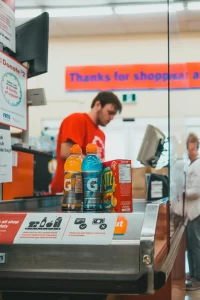If you’re aiming to unlock your grocery team’s full potential, grocery store inventory management software is the key. This powerful tool can automate manual processes, reduces errors, and optimizes stock handling. In this article, you will learn how it transforms your operations, how inventory management software changes the game, reduce employee burnout, and enhance customer satisfaction.
Key Takeaways
- Implementing grocery store inventory management software automates processes, enhances efficiency, and allows grocery teams to focus on strategic, high-value tasks.
- Real-time inventory tracking minimizes waste and boosts customer satisfaction by ensuring product availability and reducing out-of-stock situations.
- Investing in regular training for staff ensures effective use of inventory software, leading to higher accuracy, reduced burnout, and improved customer service.
The Role of Inventory Management Software in Grocery Stores
Grocery stores face unique challenges in inventory management due to the diverse range of perishable and non-perishable products they offer. Managing this inventory manually can lead to errors, inefficiencies, and increased operational costs. Powerful grocery store inventory management software automates processes, reduces errors, and optimizes operations.
Advanced inventory management systems help retailers automate ordering processes and improve inventory visibility, leading to enhanced operational efficiency. This means less time spent on manual counts and more time on strategic tasks that drive business growth. The software can revolutionize stock management by increasing accuracy, speeding up workflows, and eliminating manual errors.
Advanced inventory solutions significantly optimize operations, drive productivity, and reduce costs for grocery stores. This improved efficiency directly supports staff, enabling them to focus on higher-value tasks and better customer service.
Reducing Employee Burnout Using Automation
Employee burnout is a significant issue in the grocery industry, primarily driven by repetitive manual processes and long hours. Implementing automated solutions can significantly alleviate this workload and reduce employee stress. Automating stock monitoring and reducing manual counts with real-time tracking increases operational efficiency, enabling employees to manage their time better and focus on meaningful tasks.
Automation of tedious tasks not only helps employees concentrate on higher-value work but also reduces the need for repetitive data entry, a common source of burnout. This leads to better time management, higher employee retention rates, and ultimately enhances customer satisfaction by ensuring a more engaged and focused team.
Real-Time Inventory Tracking for Enhanced Accuracy
Real-time inventory tracking is a cornerstone of modern grocery store inventory management software, offering numerous benefits that surpass older inventory methods. These systems prevent inventory issues and ensure shelves are always stocked, leading to better sales opportunities. This not only cuts costs but also boosts profits by maintaining optimal inventory levels.
Barcode systems significantly reduce data entry errors and enhance tracking precision, leading to more accurate inventory counts. Integrating inventory management software with POS systems allows for automatic updates of stock records with each transaction, preventing lost sales without real time visibility.
Moreover, real time data and synchronization across multiple sales channels ensure that stock levels are accurate for both online sales and in-store inventory, providing a seamless customer experience. POS integration to inventory management systems provide enhanced tracking capabilities through monitoring and predicting inventory needs. This reduces the time spent handling inventory, saving valuable hours for grocery employees.
Streamlining Stock Replenishment Processes
Effective stock replenishment is crucial for maintaining smooth operations in grocery stores. Real-time demand forecasting enables businesses to align their inventory with actual market demand, minimizing waste and ensuring product availability. Analyzing data at the SKU-store level allows grocery stores to identify inefficiencies and improve stock management.
The integration of inventory management software streamlines tasks such as automatic reordering and performance analytics, reducing human errors and enhancing resource allocation. Incorporating spoilage forecasts into inventory management assists in optimizing replenishment and reducing waste.
These pricing strategies can lead to cost savings and minimize disruptions in the supply chain.
 Enhancing Customer Satisfaction Through Better Inventory Control
Enhancing Customer Satisfaction Through Better Inventory Control
Customer satisfaction hinges on product availability and the overall shopping experience. In order to unlock your grocery team’s full potential, you must use effective inventory management. It helps grocery retailers minimize waste and ensure that products are always available. With real-time inventory systems, stores can better manage perishable items, reducing waste through timely sales and stock movement.
Enhanced inventory tracking ensures that popular items are always available and easily located, improving the customer experience. Demand forecasting reduces errors in the entire supply chain network, leading to fewer out-of-stock situations and higher customer satisfaction.
A unified system provides sales staff with immediate access to inventory data, reducing wait times, and enhancing customer service.
Improving Data Accuracy and Decision Making
Accurate data is the backbone of effective inventory management and decision-making. Inventory management software can quickly identify anomalies in inventory data, enabling businesses to address potential issues before they escalate. Predictive analytics provide insights into consumer behavior and future trends, enhancing decision-making and operational efficiency.
An accurate inventory management software enhances precision, analyzes data, and maximizes supply chain effectiveness, leading to more informed inventory decisions. Using reports can improve predictions for stock needs and reduce excess inventory costs.
Ensuring data quality control, regular audits, and data validation are practices that help maintain data accuracy in inventory management.
Implementing First-In, First-Out (FIFO) Rotation
Implementing the First-In, First-Out (FIFO) rotation method is crucial for managing inventory, especially for perishable items. FIFO ensures that older stock is sold before newer stock, significantly decreasing spoilage rates and maintaining product freshness.
Ensuring that the oldest items are processed first, FIFO improves customer satisfaction by delivering fresher products and reduces waste, leading to cost savings.
Leveraging Historical Data for Demand Forecasting
Historical data is a goldmine for improving demand forecasting in grocery stores. Grocers leverage historical and day-level sales data to refine their inventory strategies and reduce stockouts. Accurate demand forecasting is essential for ensuring product availability and minimizing waste, aligning stock levels with customer demand fluctuations.
With extensive reports, you can analyze customer behavior, improve demand forecasting, and maintain optimal inventory levels. Integrating demand forecasting features with inventory management software aids in adjusting to changing consumer expectations, avoiding overstocking, and ensuring popular items remain available.
Integration with POS Systems for Seamless Operations
Integrating inventory management systems with POS systems is key to achieving seamless operations. With a bevy of real-time reports, you can analyze real-time data from sales transactions and market conditions, allowing for more responsive inventory management. Automated billing enhances checkout efficiency by minimizing manual entry errors, providing a smoother customer experience.
Integrated purchase order management systems provide transparency in procurement processes, replacing manual documentation and enhancing security and scalability across multiple locations. Such seamless integration is vital for operational efficiency and enhancing customer satisfaction.
Customizable Features to Meet Unique Store Needs
Every grocery store has unique challenges, and flexible inventory management software can be tailored to meet these specific needs. Off-the-shelf inventory management systems often face challenges due to a lack of tailored fit, but modern systems allow for automatic stock level updates upon receiving new products.
A custom inventory management system enhances strengths and minimizes weaknesses, providing a significant advantage. Data-driven insights can help foresee shifts in supplier performance and market conditions, ensuring compatibility and efficiency.
Whether it’s a large grocery store needing advanced tracking systems or a small shop requiring simpler solutions, customizable features are crucial for effective inventory management.
Training Your Team for Effective Use of Inventory Software
Training your team is essential for the effective use of inventory management software. Regular training sessions keep employees updated on new practices and system features, ensuring they are well-prepared to handle discrepancies in inventory. Employees should understand the importance of performing regular physical inventory audits to match actual stock with records.
Proper training helps employees manage inventory more efficiently, enhancing overall inventory management efficiency and customer satisfaction. Investing in training ensures staff can leverage the full potential of inventory management software.
Case Studies: Success Stories from Grocery Stores
Real-world success stories highlight the transformative impact of inventory management software. Companies like Walmart, Amazon, and GE have utilized inventory management systems to enhance efficiency and effectiveness in their operations. These implementations have led to significant improvements in inventory accuracy, reduced costs, and enhanced customer satisfaction.
For instance, Walmart’s use of inventory management has streamlined their stock replenishment processes, ensuring that products are always available and reducing waste. Similarly, Amazon’s advanced inventory systems have optimized their supply chain, resulting in faster delivery times and higher customer satisfaction.
These success stories demonstrate the potential of inventory management software to revolutionize grocery store operations.
Overcoming Common Challenges in Implementation
Implementing inventory management software comes with its own set of challenges. Shrinkage reports help grocery stores identify and address inventory levels and loss sources effectively, reducing costs and improving accuracy. Common challenges in traditional inventory management include precision tracking and effective management issues, but adopting an integrated platform can assist businesses in managing complex logistics efficiently.
Frequent stock audits, such as daily inventory counts, enhance data accuracy and reduce errors. Using barcode technology during receiving processes minimizes human errors and inventory loss.
Outsourcing inventory management expertise provides necessary training and support for effective system use, ensuring a smooth implementation process.
Future Industry Trends in Grocery Store Inventory Management
The future of grocery store inventory management is bright, with automation, predictive analytics, and real-time optimization set to revolutionize the industry. By analyzing extensive datasets, enabling more accurate demand predictions and optimizing supply chains based on consumer behavior, these technologies will minimize errors and improve processes, leading to more efficient operations.
By tailoring shopping experiences to individual preferences and meeting consumer demand, you can enhance customer loyalty and satisfaction. Additionally, self-checkout systems are expected to streamline shopping experiences by reducing wait times, making the future of grocery shopping more efficient and customer-centric.
Summary
In summary, inventory management software is a game-changer for grocery stores, offering numerous benefits from reducing employee burnout to enhancing customer satisfaction. By automating tedious tasks, ensuring real-time inventory tracking, and leveraging demand forecasting, grocery stores can optimize their operations and reduce costs.
The future trends in inventory management promise even greater efficiency and customer satisfaction. By embracing cutting edge technology, grocery stores can unlock their full potential, ensuring a brighter and more profitable future.
Additionally, modern inventory management systems offer flexibility and scalability, allowing grocery stores to adapt as market demands shift. By integrating innovative technologies, retailers can analyze trends, optimize stock levels, and enhance operational transparency. Investing in robust software solutions not only streamlines processes but also positions businesses to capitalize on growth opportunities, ensuring long-term success in an ever-evolving retail landscape. By embracing these modern innovations, grocery stores can secure a competitive edge and thrive.
Frequently Asked Questions
How does inventory management software reduce employee burnout?
Inventory management software reduces employee burnout by automating tedious tasks, freeing your team to engage in higher-value work, leading to improved job satisfaction and reduced stress. Embrace this tool to create a more efficient and happier workplace!
What are the benefits of real-time inventory tracking?
Real-time inventory tracking boosts your accuracy and keeps your shelves fully stocked, helping you avoid costly mistakes. Embracing this system can transform your business efficiency and customer loyalty!
How do reports improve demand forecasting?
Reports enhance demand forecasting by analyzing customer behavior and historical sales data, leading to precise predictions that help businesses optimize inventory and prevent stock issues. Embrace this technology to streamline your operations and boost efficiency!
What are common challenges in implementing inventory management software?
Implementing inventory management software often faces challenges like precision tracking and integration issues. Overcome these hurdles by utilizing barcode scanning technology, conducting regular stock audits, and seeking expert training and support.
What future trends are expected in grocery store inventory management?
The future of grocery store inventory management looks promising with trends like automation, predictive analytics, and personalization that will enhance efficiency and customer satisfaction. Embrace these innovations for a more streamlined shopping experience!
What are my next steps?
If you want to take control of your in store inventory and prevent excess stock, you’re in the right place. Reaching out to a business development specialist, an expert in inventory operations in retail stores, and discussing a new POS solution can help optimize inventory levels and stay on top of market trends.
Whenever you’re ready to make your next business move, you can schedule a free demo here.


 Enhancing Customer Satisfaction Through Better Inventory Control
Enhancing Customer Satisfaction Through Better Inventory Control
